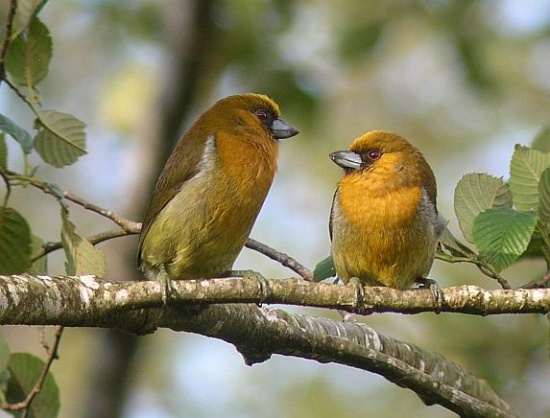- Semnornis frantzii
Identification
18 cm (7 in). This bird is plump, with a distinctive gray bill: the lower mandible has 2 little prongs and the hook on the upper mandible fits neatly between the prongs (see photo detail below).
Its head, chest and mid-belly are ochre-orange, with a black mask. The upperparts and tail are olive; flanks and lower belly are gray tinged with yellow; patch of bluish-gray on sides of breast. Its iris is dark red.
The male has a tuft of glossy, stiff, elongated black feathers on the central nape.
Distribution
South America: found in Costa Rica and western Panama. Fairly common in its limited range, and present in several protected areas (e.g. Monterverde in Costa Rica).
Taxonomy
This is a monotypic species[1].
Exact family placement uncertain, with possibilities including New World Barbets (Capitonidae), Toucans (Ramphastidae) or a small new family, Semnornithidae, including the Prong-billed Barbet and the related Toucan Barbet.
Habitat
Humid forest at altitude of 500-2800 m (1650-9200 ft). Also nearby second growth and clearings.
Behaviour
Often seen in pairs.
Diet
Largely frugivorous. Also some flowers and, while breeding, insects.
Breeding
Typically in small groups, but these split up during breeding-season where pairs are territorial. The nest cavity is excavated with its large bill in a tree. Lays 4-5 eggs.
Vocalisation
Song: Strange, "laugh-like" dueting vocalizations.
References
- Clements, JF. 2009. The Clements Checklist of Birds of the World. 6th ed., with updates to December 2009. Ithaca: Cornell Univ. Press. ISBN 978-0801445019.
- BF Member observations
Recommended Citation
- BirdForum Opus contributors. (2024) Prong-billed Barbet. In: BirdForum, the forum for wild birds and birding. Retrieved 8 November 2024 from https://www.birdforum.net/opus/Prong-billed_Barbet





